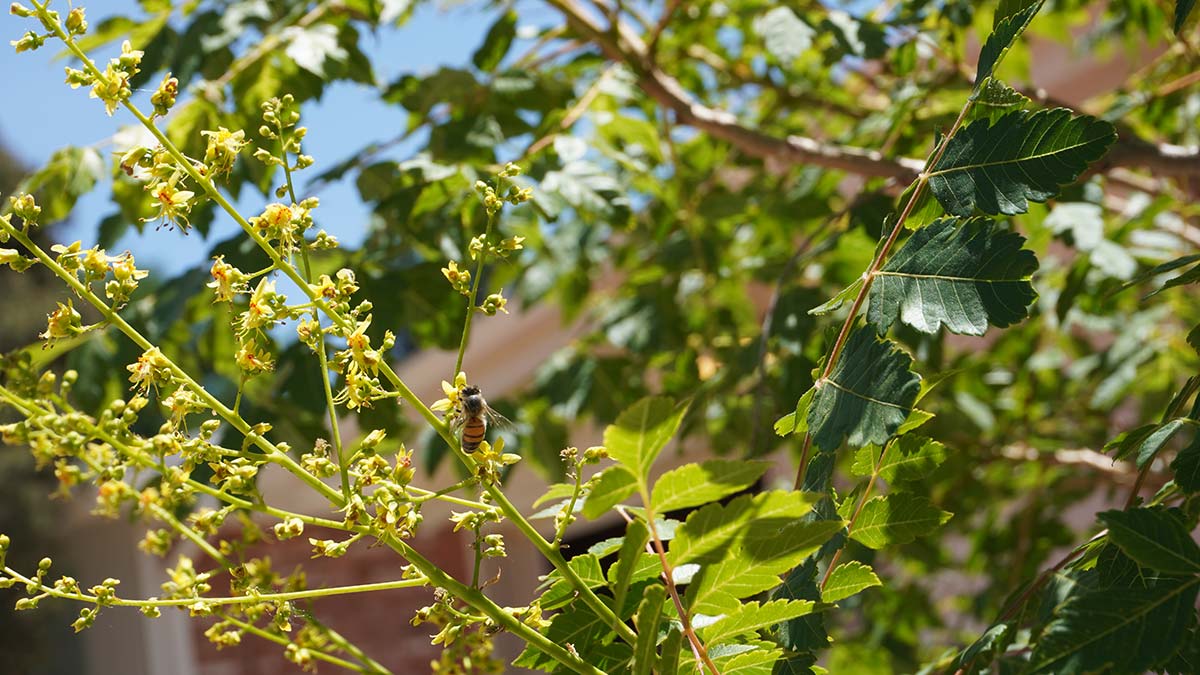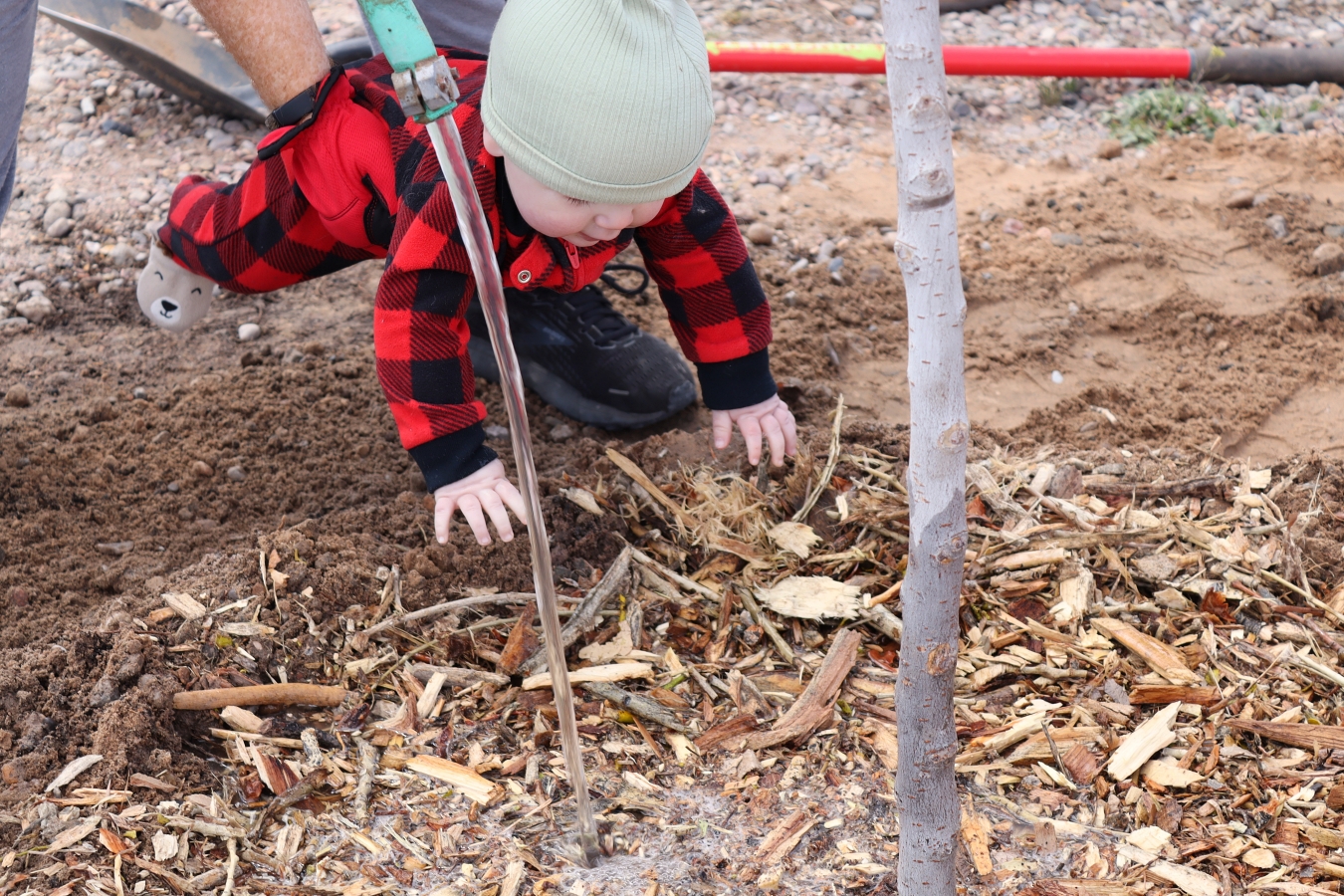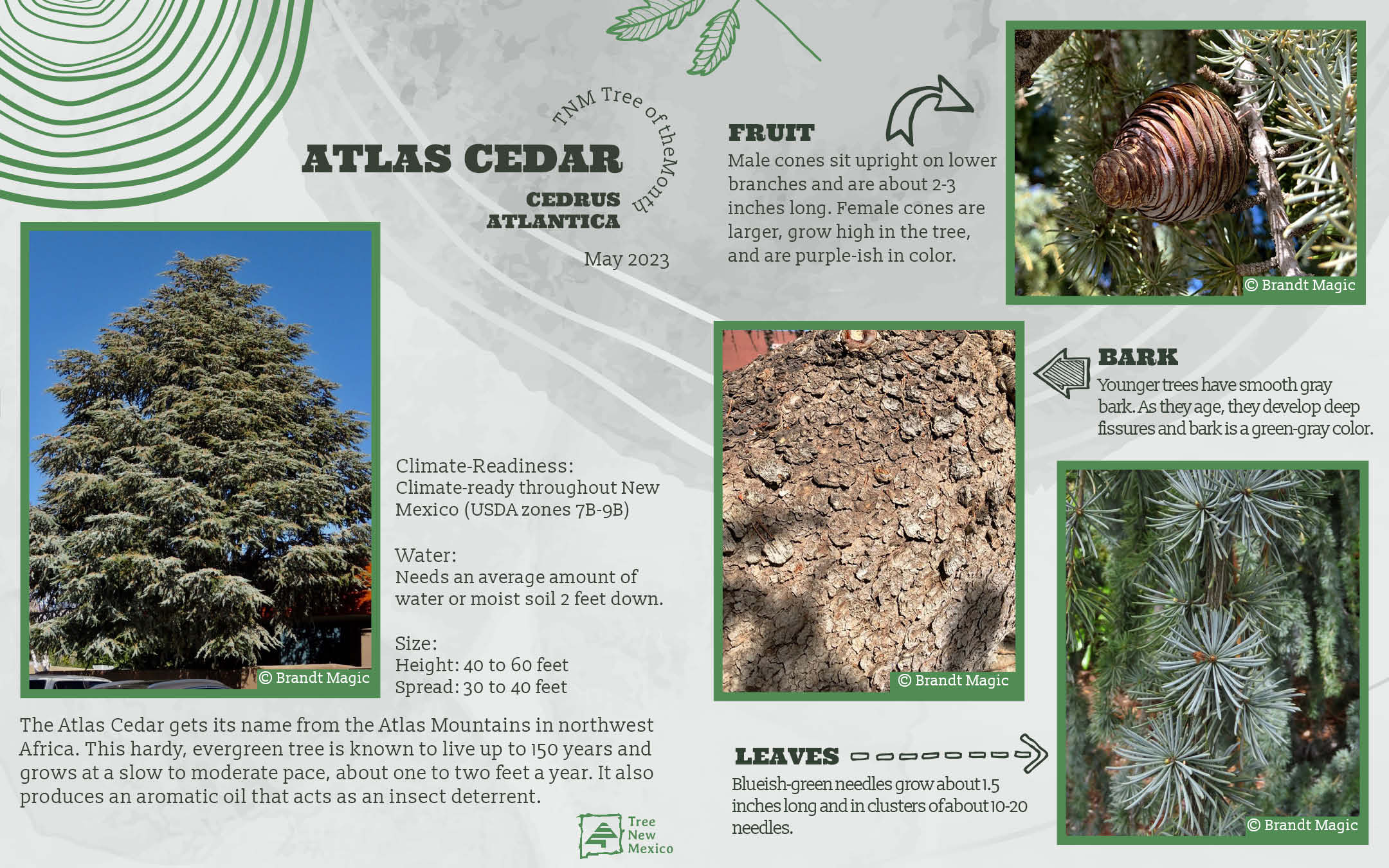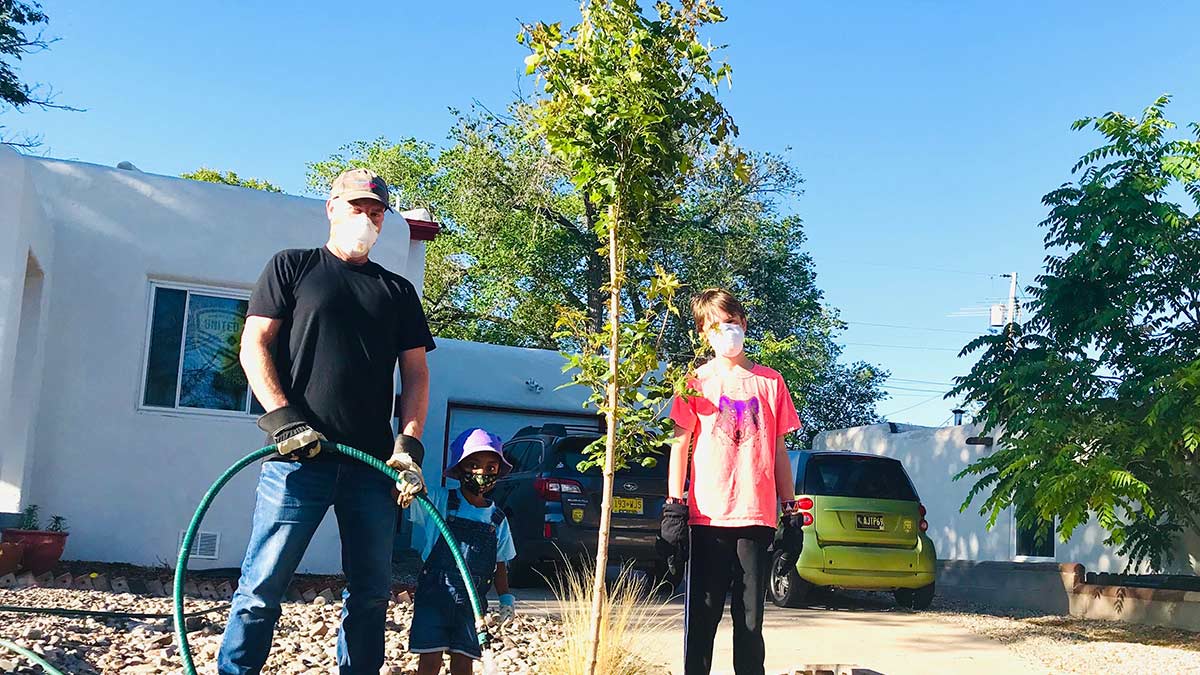
TNM Spring 2020 Update
May 21, 2020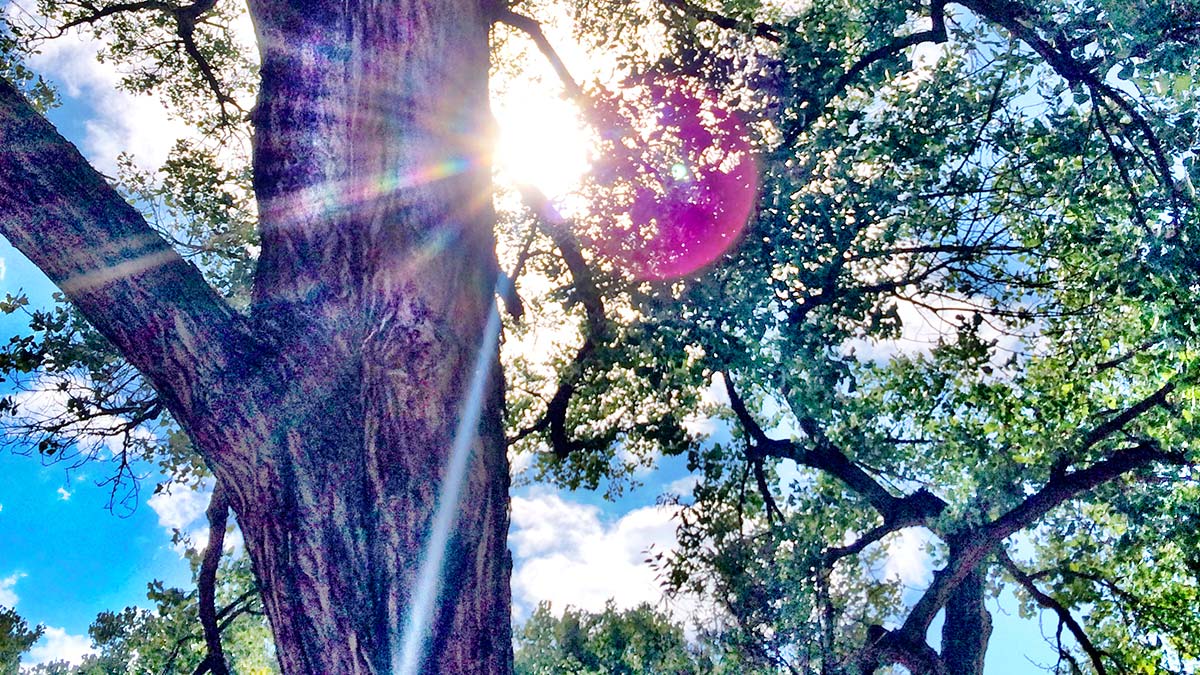
TNM 2020 Summer Newsletter
August 17, 2020We are dependent on pollinators for every source of food that we eat. Fruits and vegetables require pollination. For example, a squash plant cannot produce a zucchini and an apple tree cannot produce an apple without the help of a pollinator. If there were no pollinators, we would literally starve to death. Most of us are familiar with honeybees and know that their ability to produce honey is all about their diligent efforts to harvest pollen from many, many plants. But did you know that New Mexico has over 1000 species of native bees? This is more than any other state in the nation.
Not only do all these different species of bees serve to pollinate the plants we depend on for food, but they pollinate the flowers and shrubs living in the landscapes and greenspaces that are found within our communities. They pollinate the trees in our yards and our parks, the very trees that provide us with shade on those long New Mexico summer days.
A short list of pollinators includes not only honey and native bees, but also butterflies, moths, an assortment of flies (yes, flies!), many types of wasps, birds, and even bats. Like all creatures, pollinators are dependent on living where sources for food and water are abundant. And in the case of pollinators, other than honeybees, that habitat must also provide shelter. This means that the urban landscapes throughout your neighborhood, including parks and other greenspaces, provide vital habitat for pollinators of all sorts and sizes.
If you want to support pollinators, there are some natural and simple ways to provide habitat that support pollinators and are also good for humans. First, encourage your city to expand its greenspace and to landscape it with native plants that support wildlife. Second, provide habitat within the landscape surrounding your home. Even the landscape surrounding an apartment complex can provide habitat for many pollinators. When choosing plants for any landscape, always consider planting species that are not only native to New Mexico but also pollinator friendly. And finally, remember that when you choose to use a pesticide it kills not only the insect you are hoping to get rid of, but all of your beneficial insects as well including the pollinators.
Below is a short list of some of the trees that not only do well in our climate, but that pollinators love. These trees provide both a source of pollen and nectar. And of course, they just happen to add beauty to your surrounding landscape as well. Generally, natives and native cultivars will work best. But there are some from other environmentally similar regions of the world that do well in New Mexico. And don’t forget that any tree will need supplemental watering for – at least – the first 2-3 years as it establishes itself in its new location. Be patient and keep in mind the old adage “Sleep, Creep, Leap.” It well-describes the first 3 years of a newly planted tree.
Any Fruit Tree – How great is this? Pollinators love the nectar and pollen while they increase fruit set allowing you to enjoy the resulting bumper crop. Be advised that ornamental fruit trees are mostly self-pollinating and are therefore less attractive to pollinators, while heirloom or native fruits are very attractive.
Willows (Salix sp.) – Many species are native to New Mexico. As early bloomers, willows are very important as a spring source of pollen. Willows have added value for wind and visual screening; basketry material; and some add particular visual interest due to form or bark color. Be careful when planting willows. They are a water loving species and can quickly invade pipes carrying water below the ground.
Honey Mesquite (Prosopis glandulosa) – Yes, the mesquite flowers early in the season provide an early source of pollen, but this tree cannot survive extremely cold temperatures and will do best only in the southern regions of New Mexico. It is a relative of the New Mexico Locust (Robinia neomexicana) and other locust varieties also known to be great trees for pollinators. Most of them are also good at building healthy soil as they naturally add nitrogen through their roots interaction with air, water and carbon.
Honey Mesquite
Catalpa (Catalpa sp.) – Catalpa trees have large heart shaped leaves and provide a lot of shade that can inhibit grass from growing beneath them. In late spring and early summer, they have large showy white blossoms that pollinators feast on. These blossoms produce long dark brown seed pods that feed birds and other wildlife throughout the late fall and winter. While they are a good habitat tree, they require supplemental watering and heat stress can cause them to defoliate during intense summer temperatures. They grow 40-60’ tall and 20-40’ wide so makes sure you plant them where there is plenty of room.
Linden (Tilia sp.) – Not a native to our state but one that adapts fairly well to the New Mexico environment, lindens bloom in midsummer, so they are an important nectar bridge during the hottest months and may be an emergency food source if spring blooms are lost to late frosts. Honeybees that harvest pollen from the Linden make a wonderfully rich honey. A linden will grow 65-130’ tall with lovely smooth grey bark. This is a large tree so plant it where there is lots of room.
Tatarian Maple (Acer tataricum) – A small tree, this maple will only get about 20’ tall. But it can spread its canopy more than 25’ and it grows faster than many other trees. Small white flowers will attract bees to this small shrubby maple and are followed by winged seeds helicoptering to the ground a little later. One recommended cultivar of this species is the Hotwings® maple with its colorful red seeds and red fall foliage. It was developed for alkaline soils of the Rocky Mountain west.
Tatarian Maple
Japanese Pagoda (Sophora japonica) – This tree is especially valuable to honeybees in mid to late summer when little else is blooming. Profuse white blossoms make it an attractive tree for the home landscape. Of Asian origin, once established it adapts well to New Mexico’s soil and temperatures and can be very hearty in the upper regions of the state.
Tulip Poplars (Liriodendron tulipifera) – Native to eastern US and somewhat uncommon in New Mexico the tulip poplar adapts well to many climates and grows fast. It is a hard wood tree, unlike other poplars, and its growth habit is straight and tall to about 100’ or more at maturity, it needs a lot of room to grow. Its bark is dark brown and furrowed. Deep red winter buds are followed in April-May by lovely yellow blossoms that resemble a profusion of tulips unfolding. It provides an abundance of food for pollinators and is beautiful in the landscape.
Ashes (Fraxinus) – Most type of ash do well in New Mexico and are anywhere from a medium to large tree shade tree in size. Ash trees are presently not being recommended for planting owed to the Emerald Ash Borer, a pest that has eliminated all but a few of the mature ash trees throughout the upper Midwest United States. However, there are varieties that appear to be less susceptible to the borer and they are still available in local nurseries and provide great habitat for pollinators and shade for human beings. If you plant an ash, watch for “D” shaped openings along the trunk. This is a sign of the emerald ash borer having entered your tree. This tail-tale sign is not difficult to observe. If you see it and suspect your tree has them, contact your County Extension Agent immediately to notify them.
New Mexico Olive (Forestiera pubescens) – A native of northern NM, this small tree/large shrub is hardy once established. When the female is in bloom you will only know it for the sound of bees gathering pollen at a time when little else is available. The fall fruit is small, football shaped, a dark purple and provides the birds food throughout the winter.
Chokecherry (Prunus virginiana) – A small tree that works well as an understory tree with requiring only 6 hours a day or filtered sunlight. It blossoms in spring with white weeping spires. The fruits although mostly pit, make an amazing jelly and syrup.
Big Tooth Maple (Acer grandide ntatum) – Growing 20-30’ tall and a native maple of New Mexico, this small to medium sized shrubby tree has spring blossoms hanging in clusters of yellow and green that appear with the leaves in March/April. It is both cold and heat tolerant and provides beautiful fall color in yellows and russet reds.
Redbud (Cercis canadensis) – A small tree reaching only about 25’, each spring it provides a profusion of vivid fuschia colored blossoms. These blossoms are early food for bee populations and develop into light brown pods that birds will and other wildlife will feast upon. Its leaves follow and are heart shaped. early spring before its heart-shaped leaves appear. It prefers to be multi-trunked but can be pruned to a single stem.
Willow (salix spp.) – There are many types of willow, in all shapes and sizes. All willows produce catkins (like pussy willow) in early spring. (See picture below.) Catkins are rich in nectar and pollen and willows provide great habitat for not only pollinators, but also many other beneficial insects. Willows are also often the first tree to leaf out. Warning, do not plant a willow near water pipes or a septic system. They love water!
Texas Mountain Laurel (Sophora secundiflora) – This small multi-stemmed tree belongs to the pea family and produces bright purple clusters that hint of grape soda in March/April. Pollinators love them. Its size varies and can reach 15’ tall and 10’ wide. It grows best where the environment is hot and dry. It is not cold hearty and grows best in the lower half of the state.
Kentucky Coffee Tree (Gumnocladus dioicus) – A new tree also from the pea family that is being introduced to the SW, this tree is large and a great one for shade. It is drought and pollution resistant. The inconspicuous flower clusters appear in May/June when most of the other food providing trees have stopped. This makes the coffee tree a valuable option for providing a full growing season habitat. It has a lovely smooth dove gray colored bark and can endure the extreme temperatures experienced throughout New Mexico and will grow 60 to 70’ tall with a canopy 40 to 50’ wide.
Bur Oak (Quercus macrocarpa) – This oak will grow 60 to 70’ tall with almost as wide a canopy. Its inconspicuous blossoms in April are a great source of food for pollinators and its fall acorns an excellent food source for other wildlife. It is tolerant of drought and both dry and clay soils.
Chankapin oak (Muehlenbergii) – One of the faster growing oaks, this is also a great tree to plant as a resource for pollinators. Its April blossoms are narrow clusters in spring that provide dark colored acorn fruits in the fall. They are a wildlife favorite. A native of New Mexico and long living, this oak will grow to about 40’ tall and almost as wide with rough scabby bark.
Utah Serviceberry (Amelanchier utahensis) – More a small shrub than tree, this hardy multi-stemmed plant produces lovely white blossoms in earliest spring just as the ground begins to thaw and pollinators are desperate for something to feed on.
Golden Raintree (Koelreuteria paniculate) – With long multi-branching yellow spires of blossoms in early to mid-summer, this tree provides an excellent food source for pollinators at a time when most trees have long stopped feeding them. Originally from the Asian continent and highly adaptable to varying soils and environments, it has become a popular landscape tree throughout the US. Considered a medium sized shade tree it will grow from 25 to 40’ tall. It can tolerate dry alkaline soil, something we have a lot of in New Mexico.
Chaste Tree (Vitex agnus-castus) – Native to Indian and growing 15 to 20’ tall, this multi-stemmed tree (or small shrub if you prefer) will provide beautiful long purple or white spires of tiny blossoms when the summer becomes the hottest and driest. You will hardly notice the blossom but will hear the many species of bees feeding on them. Because it waits till the very heat of the summer, it provides a food source for pollinators when it is most needed.
Lacebark Elm (Ulmus parvifolia) – A beautiful medium to large shade tree, it is known for its beautiful patchwork bark. This tree is hearty and heat and drought tolerant. Unlike the Siberian elm (often mistakenly called the Chinese elm) it is not susceptible to Dutch elm disease and does not set prolific seed during high spring winds. This elm blooms and seeds in late summer/early fall when pollinators are storing up for winter and need a really good food source. Its leaves are small to medium in size, breaking down easily over the southwestern winter and turn a lovely yellow in the fall.
Crape Myrtle (Lagerstromia indica) – A small (15 to 20’ tall) multi-stemmed tree with deep burgundy, purple, pink or white blossoms that bloom all summer long. Unusually late in leafing out, this tree adds color and character to the landscape and blooms from early July through September. Once mature (10 to 12 years) its bark becomes uniquely smooth patches of different shades of tan and gray adding striking interest to the landscape.
Check with your County Extension Agent, Extension Master Gardeners, or a local nursery for best adapted varieties for your elevation and location is NM. For more information on pollinators and how to support them check out the Xerces Society website. For information about beekeeping see The New Mexico Beekeepers Association For information regarding pollination and our food supply see this article.

